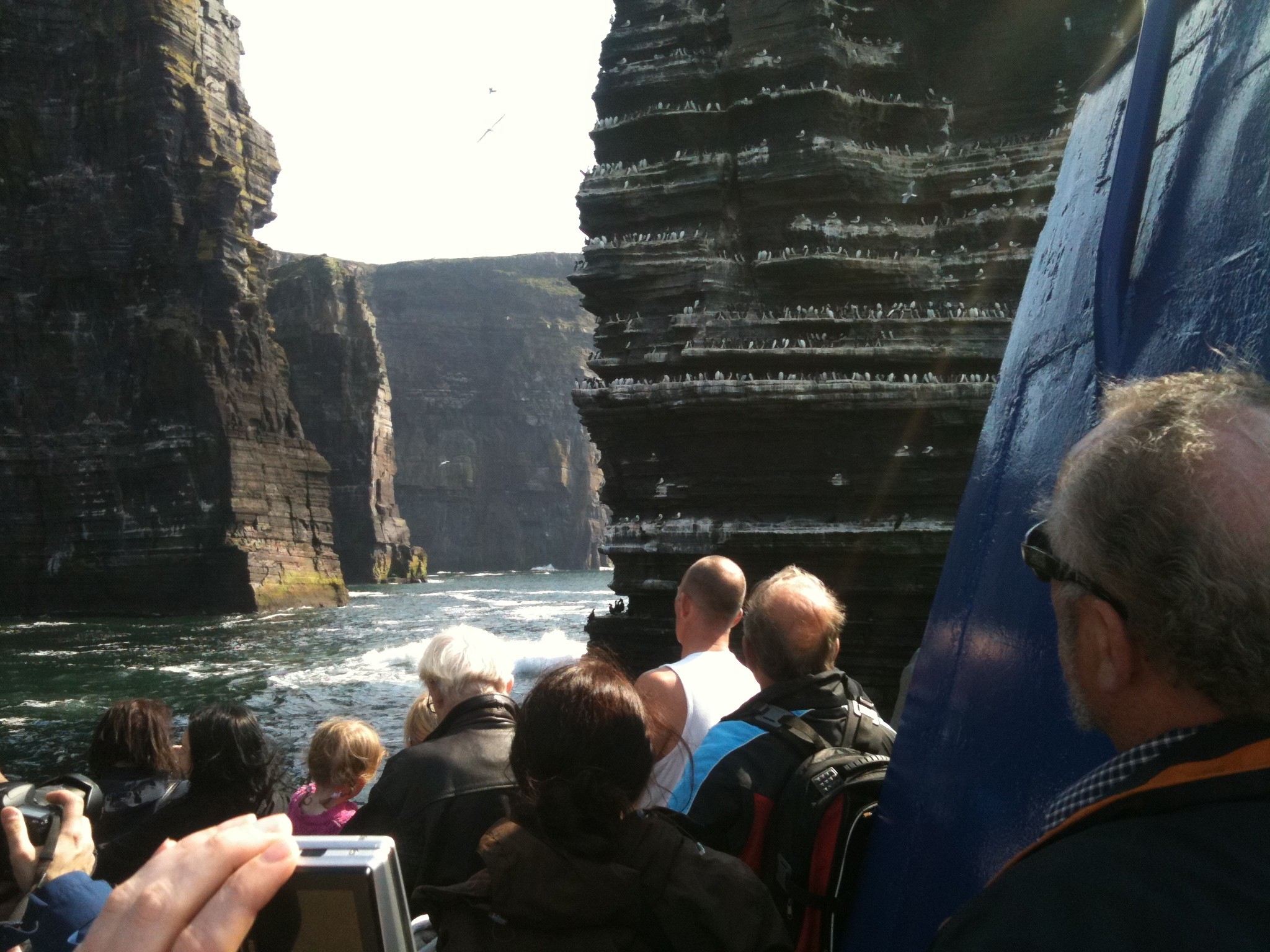Birds at the Cliffs of Moher
Some would say the Cliffs of Moher represent a must-see sight for any visitor to these shores. But for some visitors they are more than a stop on a tour itinerary – they become home for an important period of the year. These visitors are, of course, the colonies of seabirds that inhabit the cliffs making them the location of the largest mainland seabird colony in Ireland.
Without travelling over the sea to one of our offshore islands there is really no better place to view seabirds in numbers than at the Cliffs of Moher. Over 30,000 pairs of nesting seabirds can be seen during the nesting period from April to July with the months of May and June particularly impressive. The abundance of nesting sites along the cliff edges and the ability to view these from the cliff top paths make it easy for all to access this natural spectacle.
In particular internationally significant numbers of two species of the breeding sea-birds, Guillemots & Razorbills, at the Cliffs of Moher have led to designation as a Special Protected Area (SPA) under the EU Birds Directive of 1979 and Habitats Directive of 1992. According to the 2000 seabird census the Cliffs of Moher supports the largest Guillemot and Razorbill colonies in the Republic of Ireland.
Seven other species of nesting seabirds are also present with Puffins, Kittiwakes and Fulmars being the most numerous. At least 11 species of other birds can also be seen in the vicinity of the Cliffs of Moher. The rarest of these include several pairs of Chough, and a pair of Peregrine Falcon. The endangered Twite is also reputed to have been noted in the area.
The Guillemot – pronounced “Gill-I-Mott” – looks like a diminutive penguin. It belongs to the auk family and during spring and summer has a chocolate brown plumage with a white bib. In winter they lose their brown mantle and are left with a black cap and back and sometimes a long black stripe behind the eye that makes them look like they are wearing spectacles. It has a long, narrow black bill which it uses to fish for sand eels and sprats by diving from the surface. They nest on cliff ledges around April and lay their single egg on the bare rock – often on a narrow ledge. However, the egg is pear shaped so that if it rolls it does so in a circle and is less likely to fall off the nesting ledge. As a further stability measure the egg soon becomes coated with guano. After the fledgling leaves the breeding ground it follows the parents out to sea where they mass together and form large floating rafts offshore.
The Razorbill, named for its distinctive broad white striped bill, is a close but slightly smaller relative to the Guillemot. Its plumage consists of a black back, head and wings and a white breast and undercarriage. The Razorbill, at nesting, tends more to isolation on individual ledges rather than in massed squabbling colonies like the Guillemot. They will find holes in the cliff or nest under rocks. Each pair of Razorbill produce a single egg which can be coloured white, green or blue with brown and black markings.
Kittiwakes are gulls that spend the winter months far out to sea. They nest on the Cliffs of Moher on an untidy heap of seaweed lined with fine grass and rootlets, that they built on tiny ledges. The plumage is an elegant grey and white and the wingtips are frequently said to look like they have been dipped in black ink. They have a black eye and a lemon yellow beak. Their name is derived from their plaintive cry – said in legend to echo the screams of the starving during the famine.
All three species can be seen nesting on an Branaunmore (the Great Stack) just below O’Brien’s Tower and indeed the stack could be considered a high rise dwelling for the multitudes of birds that make it home each year. It is frequently streaked in horizontal layers of white guano. To add to the attraction of the Stack on the flat platform at its base Shags can often be seen at low tide drying their outstretched wings.
The Puffin is one of the most popular species of seabird with its white waistcoat and cheeks and black hood, neck and back. This clown of the cliffs waddles on bright reddish orange legs across Goat Island – the long low promontary below O’Briens Tower, where a large number of the puffin burrows are located. The plates of its distinctive multicoloured bill fall off after the breeding season and in winter the puffin looks quite different. The bill grows back again in time for the next season. This bill is edged with razor-sharp serrations allowing them to carry upto twenty sand eels cross-wise back to their nests. To underscore his comical reputation the puffin’s cry sounds like a hoarse, growling laugh. Puffin pairs return to the same burrow and raise a single puffling chick. In early to mid July they take to the water and the adult birds will spend a week or so near the Cliffs with the fledged chicks accustoming them to the water before departing for the open ocean where they will spend the rest of the year until it is time to return at the end of March.
The Fulmar is a member of the petrel family although they resemble a gull. A combination of their white body and the comparative thickness of their head had led to them being nicknamed “the flying milk bottle.” But the Fulmar holds a surprise for unwary predators. It spits a foul smelling yellowish stomach fluid at attackers. This has probably contributed to its name which comes from Old Norse and translates as “Foul Cry”. Fulmar can be seen all year round and are noticeable soaring on thermals on their stiff winged flight.
Many of the seabirds winter at sea and return to their colonies at the Cliff of Moher in late winter or early spring. Their nesting seasons vary with most including the months of April to June. Species like Fulmar and Guillemot can be seen at the Cliffs all year round along with Chough, Peregrine Falcon, Ravens and many more common species.
Katherine Webster
Director – Cliffs of Moher Visitor Experience




